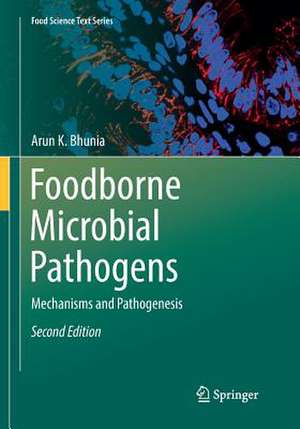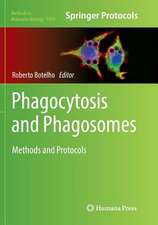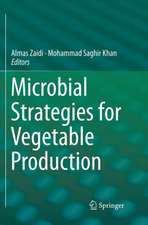Foodborne Microbial Pathogens: Mechanisms and Pathogenesis: Food Science Text Series
Autor Arun K. Bhuniaen Limba Engleză Paperback – 25 iul 2019
| Toate formatele și edițiile | Preț | Express |
|---|---|---|
| Paperback (1) | 593.26 lei 6-8 săpt. | |
| Springer – 25 iul 2019 | 593.26 lei 6-8 săpt. | |
| Hardback (1) | 743.27 lei 6-8 săpt. | |
| Springer – 22 mai 2018 | 743.27 lei 6-8 săpt. |
Din seria Food Science Text Series
- 17%
 Preț: 502.96 lei
Preț: 502.96 lei - 17%
 Preț: 469.19 lei
Preț: 469.19 lei - 15%
 Preț: 549.39 lei
Preț: 549.39 lei - 20%
 Preț: 579.81 lei
Preț: 579.81 lei -
 Preț: 458.78 lei
Preț: 458.78 lei - 15%
 Preț: 566.10 lei
Preț: 566.10 lei - 13%
 Preț: 358.76 lei
Preț: 358.76 lei - 15%
 Preț: 635.76 lei
Preț: 635.76 lei -
 Preț: 396.40 lei
Preț: 396.40 lei -
 Preț: 482.23 lei
Preț: 482.23 lei -
 Preț: 392.37 lei
Preț: 392.37 lei -
 Preț: 398.35 lei
Preț: 398.35 lei - 15%
 Preț: 508.60 lei
Preț: 508.60 lei - 15%
 Preț: 508.75 lei
Preț: 508.75 lei - 15%
 Preț: 587.39 lei
Preț: 587.39 lei - 18%
 Preț: 965.83 lei
Preț: 965.83 lei -
 Preț: 393.13 lei
Preț: 393.13 lei - 15%
 Preț: 532.70 lei
Preț: 532.70 lei -
 Preț: 474.31 lei
Preț: 474.31 lei - 15%
 Preț: 658.05 lei
Preț: 658.05 lei - 15%
 Preț: 600.74 lei
Preț: 600.74 lei - 18%
 Preț: 971.22 lei
Preț: 971.22 lei - 15%
 Preț: 477.74 lei
Preț: 477.74 lei - 18%
 Preț: 1010.33 lei
Preț: 1010.33 lei - 15%
 Preț: 477.74 lei
Preț: 477.74 lei - 15%
 Preț: 574.25 lei
Preț: 574.25 lei
Preț: 593.26 lei
Preț vechi: 697.96 lei
-15% Nou
Puncte Express: 890
Preț estimativ în valută:
113.54€ • 118.09$ • 93.73£
113.54€ • 118.09$ • 93.73£
Carte tipărită la comandă
Livrare economică 14-28 aprilie
Preluare comenzi: 021 569.72.76
Specificații
ISBN-13: 9781493992461
ISBN-10: 1493992465
Pagini: 365
Ilustrații: XXVI, 365 p. 133 illus., 114 illus. in color.
Dimensiuni: 178 x 254 mm
Greutate: 0.68 kg
Ediția:Softcover reprint of the original 2nd ed. 2018
Editura: Springer
Colecția Springer
Seria Food Science Text Series
Locul publicării:New York, NY, United States
ISBN-10: 1493992465
Pagini: 365
Ilustrații: XXVI, 365 p. 133 illus., 114 illus. in color.
Dimensiuni: 178 x 254 mm
Greutate: 0.68 kg
Ediția:Softcover reprint of the original 2nd ed. 2018
Editura: Springer
Colecția Springer
Seria Food Science Text Series
Locul publicării:New York, NY, United States
Cuprins
Introduction to Foodborne Pathogens.- Biology of Bacterial Pathogens.- Host Defense against Foodborne Pathogens.- General Mechanism of Pathogenesis.- Animal and Cell Culture Models to Study Foodborne Pathogen.- Foodborne Viral Pathogens and Infective Protein.- Foodborne Parasites.- Molds and Mycotoxins.- Fish and Shellfish Toxins.- Staphylococcus aureus.- Bacillus cereus and Bacillus anthracis.- Clostridium botulinum, Clostridium perfringens, Clostridium difficile.- Listeria monocytogenes.- Escherichia coli.- Salmonella enterica.- Campylocbacter and Arcobacter.- Yersinia enterocolitica and Yersinia pestis.- Vibrio cholerae, Vibrio parahaemolyticus, and Vibrio vulnificus.- Shigella species.- Opportunistic and Emerging Foodborne Pathogens: Aeromonas hydrophila, Plesiomonas shigelloides, Cronobacter sakazakii, and Brucella abortus.
Notă biografică
Prof. Arun K. Bhunia received his bachelor of veterinary medicine degree (BVSc) from West Bengal University of Fishery and Animal Sciences (West Bengal, Kolkata India), PhD from University of Wyoming (USA), and postdoctoral training from University of Arkansas (USA). Currently, he is a professor of food microbiology at Purdue University (USA) and the Chair of Microbiology Training Group of Purdue University interdisciplinary Life Sciences program (PULSe). He is also affiliated with the Department of Comparative Pathobiology, and Center for Food Safety and Engineering. His expertise is in the area of microbial pathogenesis, microbial food safety, foodborne pathogen detection, and probiotic vaccine. To date, he has coauthored more than 166 peer-reviewed research publications, 2 textbooks (Fundamental Food Microbiology; Foodborne Microbial Pathogens), edited four books, and delivered over 120 talks in national and international venues. He teaches both graduate and under graduate levelcourses on foodborne pathogens and mechanism of pathogenesis, microbial detection techniques, and food safety and public health. He is awarded four patents. He is serving as editor or editorial board member for several journals. He is an active member of Institute of Food Technology (IFT), International Association for Food Protection (IAFP), and American Society for Microbiology (ASM), and the USDA National Advisory Committee on Microbiological Criteria for Foods (NACMCF; 2013-2017). He has received Purdue Agriculture Research Award (2003), Purdue Faculty Scholar (2005), Purdue Team Award (2006), IFT R&D Award (2009), Outstanding Graduate Educator Award from the Department of Food Science (2010, 2011) and the College of Agriculture (2013) at Purdue University, High-End Foreign Experts Recruitment Program (China) fellowship (2014-2016), Fulbright Specialist Roster (2016-2021), and (IAFP) Maurice Weber Laboratorian Award (2017).
Textul de pe ultima copertă
This book primarily covers the general description of foodborne pathogens and their mechanisms of pathogenesis, control and prevention, and detection strategies, with easy-to-comprehend illustrations. The book is an essential resource for food microbiology graduate or undergraduate students, microbiology professionals, and academicians involved in food microbiology, food safety, and food defense-related research or teaching. This new edition covers the significant progress that has been made since 2008 in understanding the pathogenic mechanism of some common foodborne pathogens, and the host-pathogen interaction. Foodborne and food-associated zoonotic pathogens, responsible for high rates of mortality and morbidity, are discussed in detail. Chapters on foodborne viruses, parasites, molds and mycotoxins, and fish and shellfish are expanded. Additionally, chapters on opportunistic and emerging foodborne pathogens including Nipah virus, Ebola virus, Aeromonas hydrophila, Brucella abortus, Clostridium difficile, Cronobacter sakazakii, and Plesiomonas shigelloides have been added. The second edition contains more line drawings, color photographs, and hand-drawn illustrations.
Caracteristici
This second edition covers the significant progress that has been made since 2008 in understanding the pathogenic mechanism of some common foodborne pathogens, and the host-pathogen interaction Chapters on opportunistic and emerging foodborne pathogens including Nipah virus, Ebola virus, Aeromonas hydrophila, Brucella abortus, Clostridium difficile, Cronobacter sakazakii, and Plesiomonas shigelloides have been added Foodborne and food-associated zoonotic pathogens, responsible for high rates of mortality and morbidity, are discussed in detail






















